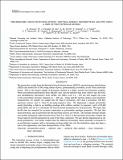Por favor, use este identificador para citar o enlazar a este item:
http://hdl.handle.net/10261/135234COMPARTIR / EXPORTAR:
 SHARE SHARE
 CORE
BASE CORE
BASE
|
|
| Visualizar otros formatos: MARC | Dublin Core | RDF | ORE | MODS | METS | DIDL | DATACITE | |

| Título: | The Herschel Orion protostar survey: spectral energy distributions and fits using a grid of protostellar models |
Autor: | Furlan, E.; Osorio, Mayra CSIC ORCID ; Allen, L. | Palabras clave: | Circumstellar matter Infrared Stars Methods: data analysis Stars: formation Stars: protostars |
Fecha de publicación: | 6-may-2016 | Editor: | Institute of Physics Publishing | Citación: | Astrophysical Journal - Supplement Series 224(1): 5 (2016) | Resumen: | We present key results from the Herschel Orion Protostar Survey: spectral energy distributions (SEDs) and model fits of 330 young stellar objects, predominantly protostars, in the Orion molecular clouds. This is the largest sample of protostars studied in a single, nearby star formation complex. With near-infrared photometry from 2MASS, mid and far-infrared data from Spitzer and Herschel, and submillimeter photometry from APEX, our SEDs cover 1.2-870 mu m and sample the peak of the protostellar envelope emission at similar to 100 mu m. Using mid-IR spectral indices and bolometric temperatures, we classify our sample into 92 Class 0 protostars, 125 Class I protostars, 102 flat spectrum sources, and 11 Class II pre-main-sequence stars. We implement a simple protostellar model (including a disk in an infalling envelope with outflow cavities) to generate a grid of 30,400 model SEDs and use it to determine the best-fit model parameters for each protostar. We argue that far-IR data are essential for accurate constraints on protostellar envelope properties. We find that most protostars, and in particular the flat-spectrum sources, are well fit. The median envelope density and median inclination angle decrease from Class 0 to Class I to flat spectrum protostars, despite the broad range in best-fit parameters in each of the three categories. We also discuss degeneracies in our model parameters. Our results confirm that the different protostellar classes generally correspond to an evolutionary sequence with a decreasing envelope infall rate, but the inclination angle also plays a role in the appearance, and thus interpretation, of the SEDs. | Descripción: | Furlan, E. et. al. | Versión del editor: | http://dx.doi.org/10.3847/0067-0049/224/1/5 | URI: | http://hdl.handle.net/10261/135234 | DOI: | 10.3847/0067-0049/224/1/5 | ISSN: | 0067-0049 | E-ISSN: | 1538-4365 | ISMN: | 10.3847/0067-0049/224/1/5 |
| Aparece en las colecciones: | (IAA) Artículos |
Ficheros en este ítem:
| Fichero | Descripción | Tamaño | Formato | |
|---|---|---|---|---|
| IAA_2016_ApJS_224(1).pdf | 7,07 MB | Adobe PDF |  Visualizar/Abrir |
CORE Recommender
SCOPUSTM
Citations
132
checked on 13-abr-2024
WEB OF SCIENCETM
Citations
127
checked on 24-feb-2024
Page view(s)
261
checked on 23-abr-2024
Download(s)
330
checked on 23-abr-2024
Google ScholarTM
Check
Altmetric
Altmetric
NOTA: Los ítems de Digital.CSIC están protegidos por copyright, con todos los derechos reservados, a menos que se indique lo contrario.
